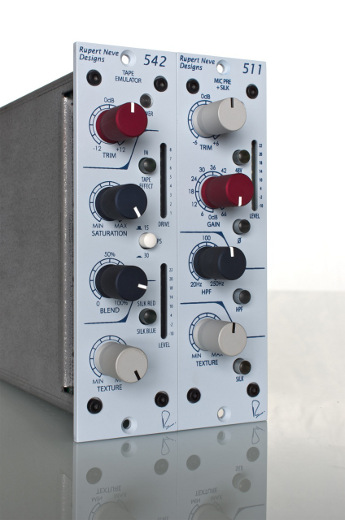Rupert Neve Designs Launches Two New 500 Modules — 511 Mic Pre, 542 True Tape Emulator
One of the premier pedigrees in audio has two new modules for the rapidly intensifying 500 Series sector.
Rupert Neve Designs has just announced arrival of the 511 Mic Pre with Silk, and the 542 True Tape Emulator with Texture. The modules stand as two of the only 500-Series modules actually designed by Mr. Rupert Neve. According to their creator, they combine the classic tone and versatility that are synonymous with a Rupert Neve design, for the form factor and value of the 500-Series format.
The 511 lists for $650, while the 542 is available for $895. There’s a lot more to say about these units, and we’ll let the legends themselves tell you all about them:
”With a truly legendary preamp and the flexibility of variable Silk/Texture, the 511 provides exceptional sonic performance and flexibility for only $650 (list). Incorporating the pristine preamp circuitry from the 517, the universally useful sweepable high-pass filter from the 5012, and the power of a variable silk circuit derived from the flagship Portico II Channel, the 511 is a Rupert Neve-designed workhorse for all your most important tracks.
For company founder and lead designer Rupert Neve, the design process was far more intensive than copying existing designs. ‘Although creating a functional 500-Series mic pre is relatively simple, designing those modules to equal their non-500-Series counterparts with the current, voltage and space restraints is quite challenging. In creating the 511 we experimented with a number of different transformer and circuit topologies to achieve the same presence and sweetness found in the Portico Series of modules. The result of these efforts is that outside of the slightly lowered headroom, the 511’s performance is nearly indistinguishable from standard Portico Series modules.’
The 511 can be used for either mic or line sources, and pairs perfectly with any ribbon, dynamic, condenser or tube microphone. A polarity-reverse switch is available to conquer phase issues when using multiple microphones. The 12dB / octave swept high-pass filter can be dialed-in to remove rumble with minimal artifacts, and also to control proximity effect in close-mic’d vocals or other sources. To coax more rich harmonic content from the output transformer, the Silk Red mode can be engaged to add more thickness and sparkle in the high end as the Texture level is increased. While a little Silk Red can sound great on nearly any source, it is especially useful on dynamic and ribbon microphones that are inherently lacking in high-frequency energy & excitement.
The second new module, the 542, is a follow-up to the acclaimed Portico 5042. As such, it delivers a remarkable simulation of classic tape sound through the inclusion of genuine tape drive circuitry while also incorporating a number of new methods for adding analogue color to individual tracks and mixes.
The 542’s ‘True Tape’ emulation circuit provides the nostalgic rounding and compression typically achieved only through the use of tape, and can offset the harshness often found in digital recordings. Unlike digital emulations, the ‘True Tape’ drive circuit works by feeding a tiny magnetic ‘record head’, which in turn is coupled to a correctly-equalized replay amplifier. As the voltage rises on the ‘record head,’ saturation increases, and a soft-clip circuit engages at higher levels to round off harsh peak transients. The sound of the tape circuit can be further modified with selectable 15 & 30 IPS modes, providing a ‘saturation equalization’ of sorts, and a pre/post-tape blend control. In addition to the tape circuit, the 542 also includes the variable Silk / Texture circuitry found in the Portico II series of modules (with both much-loved Red & Blue modes), which allows the engineer to fine-tune the harmonic ratio and tonality of the output transformer.
For engineers, the 542 is an intuitive and dynamic tonal control. The non-linear qualities of the True Tape head, Soft-Clip and Silk circuits can be combined and tuned by simply adjusting the saturation, blend and texture controls. These effects can help breathe new life into sterile tracks and enhance performances with their dynamic response. For example, a snare drum captured with a dynamic microphone that sounds anemic and ‘dead’ in the high-end could be run through the 542’s tape and Red Silk circuits to simultaneously thicken the low end and sweeten the high end. If the snare is overly dynamic, the saturation knob can push the signal into soft-clip mode, thus reducing transient spikes. Additionally, the blend control can be used to preserve the drum’s natural dynamics and transient content even with more extreme applications of soft-clip and saturation.”
Similarly, using two 542s across a mix, the gain staging can be optimized such that the tape circuit provides extra intensity and excitement in the loudest sections before final compression and limiting. Using this technique can help retain a more dynamic feel, even after the dynamics have been reduced, as the instances with the most compression correspond to the instances that have more pleasant harmonic distortion provided by the True Tape circuitry.
With the introduction of the 511 and 542 to the Portico 500 Series, which also includes the existing 517 Mic Pre / Compressor / DI and the 543 Mono Compressor, the 500 Series now has four of the most versatile tone controllers and mic preamps available on the market.”
Please note: When you buy products through links on this page, we may earn an affiliate commission.







